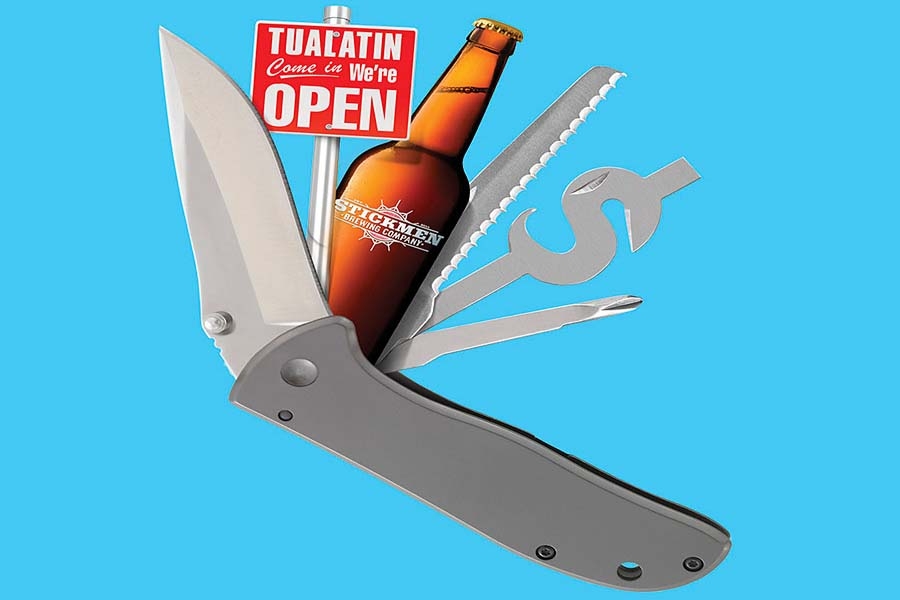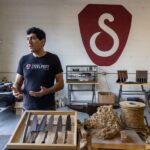Knife companies hone the economies of Tigard and Tualatin as the region itself carves out a new identity.
Tigard economic development manager Lloyd Purdy is glad to have knife and outdoor gear maker Gerber in his patch of the southern Portland metro area. The company helps him lure outside investment to the city of 50,400, and it continues to grow after spawning a local knife industry that has put Oregon on a global knifemaking map that includes Solingen, Germany, and Seki, Japan.
“There’s an interesting business cluster here for that type of advanced manufacturing,” Purdy says. “Gerber is a very interesting part of that sector, which is responsible for 23% of our economy. When we receive a request from out-of-state, I point to companies like Gerber. I say, ‘They found success in the Portland region; you could too.’”
Gerber, once an advertising company, morphed into a knifemaker in the first part of the last century on a quirk and has given birth to an entire 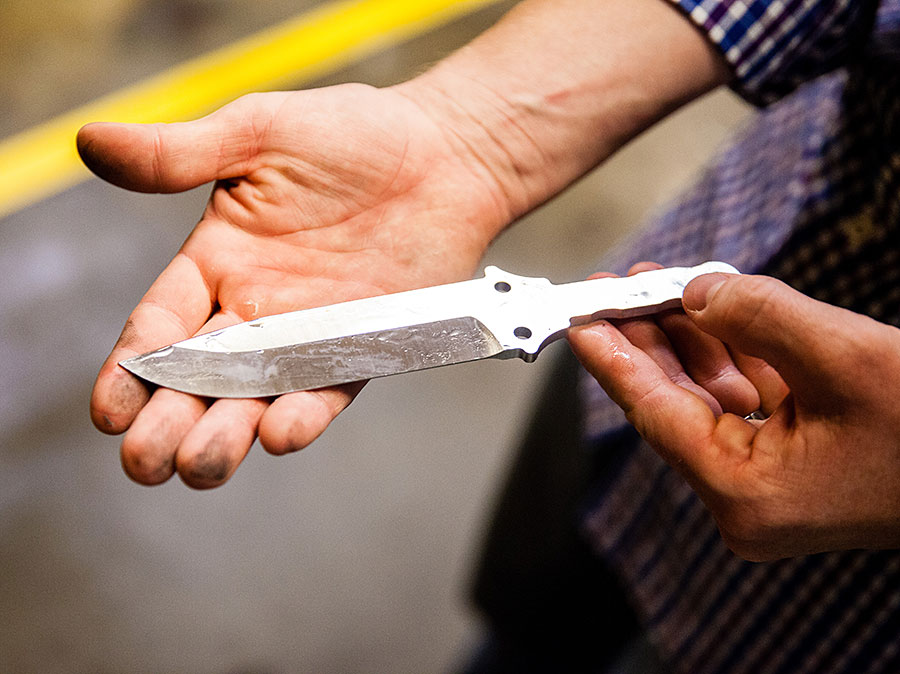 industry that has convinced at least one other U.S. knifemaker to relocate. Although the industry directly accounts for 2,200 jobs in the entire Portland region — only 1% of the workforce — it’s still helping Tualatin, Tigard and other nearby towns and cities grow. Tens of thousands commute daily to the two cities, lured by the above-average wages of Gerber and its ilk, as well as semiconductor plants and suppliers, the area’s main employer.
industry that has convinced at least one other U.S. knifemaker to relocate. Although the industry directly accounts for 2,200 jobs in the entire Portland region — only 1% of the workforce — it’s still helping Tualatin, Tigard and other nearby towns and cities grow. Tens of thousands commute daily to the two cities, lured by the above-average wages of Gerber and its ilk, as well as semiconductor plants and suppliers, the area’s main employer.
Pocket knives are an integral part of any American outdoor story and are part of Portland’s broader outdoor industry and image. They also tie in with the area’s love of handcrafts while diversifying the workforce. Only a minority of the knives sold by Portland’s knife industry are made here, but a majority of the jobs, many of them high paying, are concentrated in the southern Portland metro area.
Amy Vander Vliet, a regional economist in Portland for the Oregon Employment Department, says the actual employment figure that can be attributed to the knife industry — she calls it “cutlery” — is larger because of suppliers and other service providers that support the companies. Steel makers, for example. Distributors. The UPS guy.
“Even though it’s ‘small’, that doesn’t mean it’s not important to our economy,” Vander Vliet says via email.
“Not every industry can be, or necessarily should be, a giant like our semiconductors or sports/apparel industries. Diversity within and outside of manufacturing is important. It tends to make an economy more resilient.” While employment in the cutlery sector is down 4.3% nationwide over the past five years, she says employment levels in Portland’s knife business have stayed level, or, as she puts it, “resilient.”
“Many of these jobs don’t require a college education although they are highskilled,” she says.
Development on the outskirts of Portland’s metro boundary is important since it draws on a wide-ranging workforce, offers different locations for jobs — reducing traffic — and provides lower- cost real estate for companies that are just getting started or need more space. Tigard and Tualatin are especially well located because they offer lower-priced property with direct access to other areas of Portland, as well as highways in all four directions.
***
That the area has caught the attention of those outside the Portland area can be seen in several high-profile political and economic developments, including the September election of Tigard’s mayor as president-elect of the Oregon Mayors Association.
The area’s 57,700 total jobs account for 6.1% of jobs in the Portland metro area but just 5.3%, or $2.8 billion, of its wages, according to Vander Vliet. Together, the cities have 8,300 manufacturing jobs, representing 7.3% of all production jobs in the region. In advanced manufacturing, where cutlery falls, the average wage in Portland was $64,175 in 2015, above the national average.
“Fifty years ago, this was an old farm town,” Purdy, the Tigard economic development manager, says. He’s discussing a $2 million September grant from the U.S. Department of Commerce’s Economic Development Administration.
The agency awards about $4 million in development grants each year to Oregon, giving Tigard half that estimated haul in 2016. The state will kick in an equal amount, and a developer will also pick up some of the $5.7 million tab for improving public access and transportation, as well as sewer and water service to a 40-acre industrial site in Tigard known as the Hunziker Industrial Core.
“Once this gets developed, we’re out of industrial land,” he says.
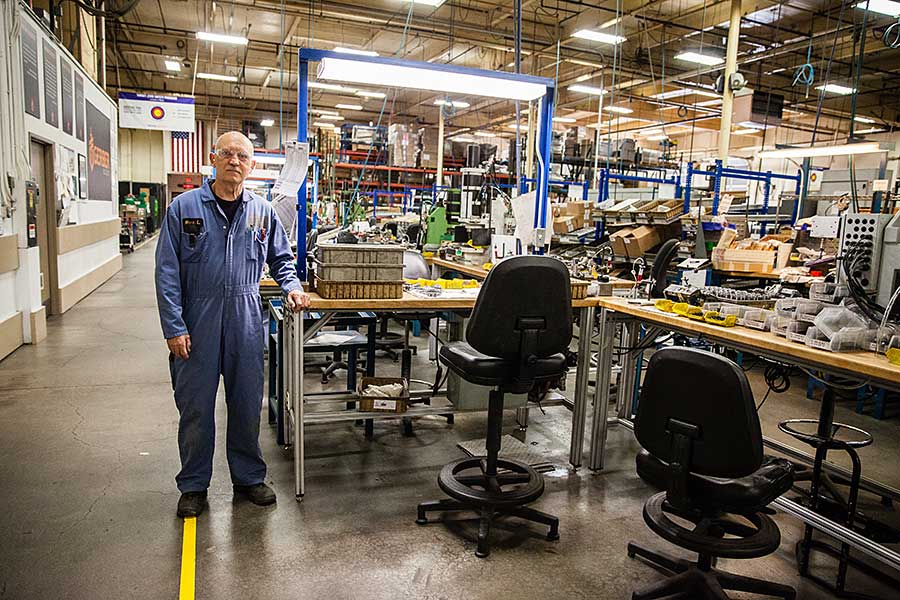 A maintenance supervisor at the Gerber plant, which runs 24 hours a day, seven days a week. | Photo by Jason Kaplan
A maintenance supervisor at the Gerber plant, which runs 24 hours a day, seven days a week. | Photo by Jason Kaplan
And when it’s developed, Purdy will likely deserve plenty of credit. He was brought onboard three years ago to guide Tigard’s economic growth, and it’s already paying dividends for the city. He applied for the grant and also created the Tigard/Lake Oswego Enterprise Zone, which allows companies within the zone to write off all of their new investment in property and equipment against property taxes.
In return they agree to invest at least $500,000, boost their payroll by 10% and pay most new employees at least double minimum wage. The zone is a strip of land along the I-5 corridor that stretches into Lake Oswego for the simple reason that Purdy wanted to be a good neighbor.
Gerber is one of the companies taking advantage of the zone. There were other knifemakers in Portland before Gerber — iconic Leatherman comes to mind. But Gerber is the industry’s biological parent. It was founded as a Portland advertising company in 1910 but entered knifemaking with Gerber Legendary Blades in 1939. Founder Joseph Gerber converted into a side business locally designed knives he sent as Christmas presents to clients. His son Peter then took over in 1951, relocating to its current headquarters in Tigard in 1966 and refocusing on sport and military blades.
For its rough-and-tumble image — it’s one of the largest knife suppliers to the U.S. military — Gerber’s headquarters are decidedly nondescript, sandwiched between a massive body shop and a commercial vehicle parts maker just a few steps from I-5. The outside hasn’t been updated since the ’60s, and an overgrown sign impossibly warns that the stream dividing the company’s parking lot from the highway is a protected environment.
“We have dozens of folks who have been here over 30 years,” says Andrew Gritzbaugh, Gerber’s director of marketing communications.
He’s leading a 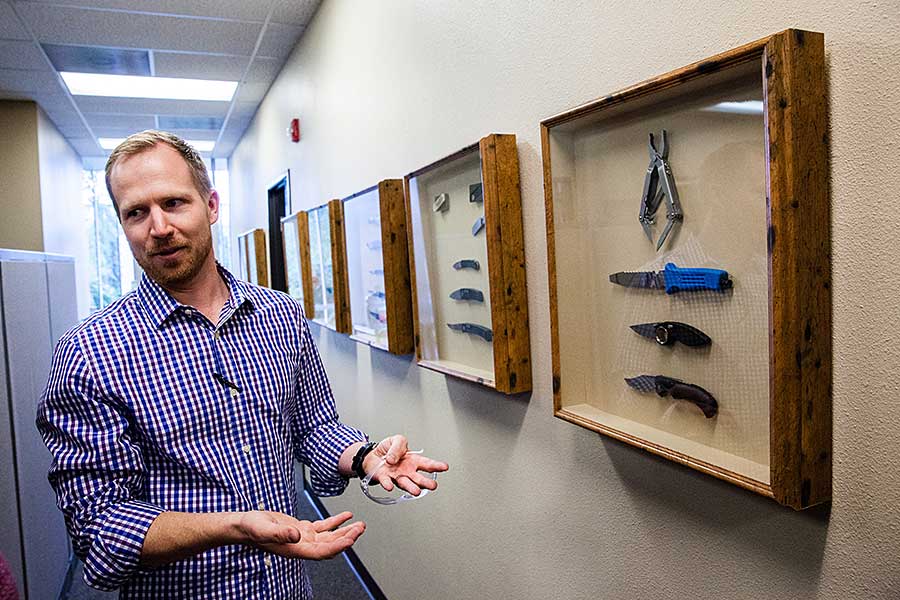 tour of the company’s plant floor, which is referred to as the “back office” and is startlingly diverse. Knife blanks are stamped from sheets of stainless steel. Rubber is molded onto handles. And in one corner, a handful of men hand-sharpen every Gerber blade on giant grinders. In another, a group of women are packaging product, which is then readied for shipment or storage.
tour of the company’s plant floor, which is referred to as the “back office” and is startlingly diverse. Knife blanks are stamped from sheets of stainless steel. Rubber is molded onto handles. And in one corner, a handful of men hand-sharpen every Gerber blade on giant grinders. In another, a group of women are packaging product, which is then readied for shipment or storage.
Between 40% and 45% of Gerber’s output is handmade in Tigard; the rest in Asia and Europe. Finnish outdoor and household goods company Fiskars bought Gerber in the late ’80s, but no one from corporate works at the site.
In early October, the plant went round the clock, adding 80 people to its workforce to meet growing demand from, among others, soldiers who took a liking to the Gerber gear they were issued while fighting America’s wars. The company is investing in new equipment as well, making its growth perfectly timed to Tigard’s new enterprise zone.
Gerber has added 129 new jobs since 2013, Gritzbaugh says, and now employs 378, a 35% increase. In 2015, according to Fiskars’ annual report, Gerber accounted for about 8% of its €1.1 billion ($1.21 billion) in revenue, or somewhere in the ballpark of $100 million.
***
Gerber’s first baby was Kershaw knives, founded in 1974 and now located 4 miles southwest in Tualatin. Pete Kershaw had researched producing Gerber knives in Japan, but Gerber turned down the idea. So Kershaw implemented it on his own. The company was acquired by onetime supplier Kai Group, of Tokyo, in 1977. Kershaw, formally known as Kai USA Ltd., relocated to Tualatin in 2003 after outgrowing its Wilsonville factory.
“It wasn’t until the mid-’90s that we started manufacturing knives in the U.S., first in Wilsonville, and then later here in Tualatin. So we actually brought production from Japan to the U.S.,” says Thomas Welk, the director of sales and marketing for Kai USA’s sporting division. He says their payroll grew by 13% last year to 260. It also works with 85 contractors and had its highest revenue ever last year, though he stops short of quoting a figure.
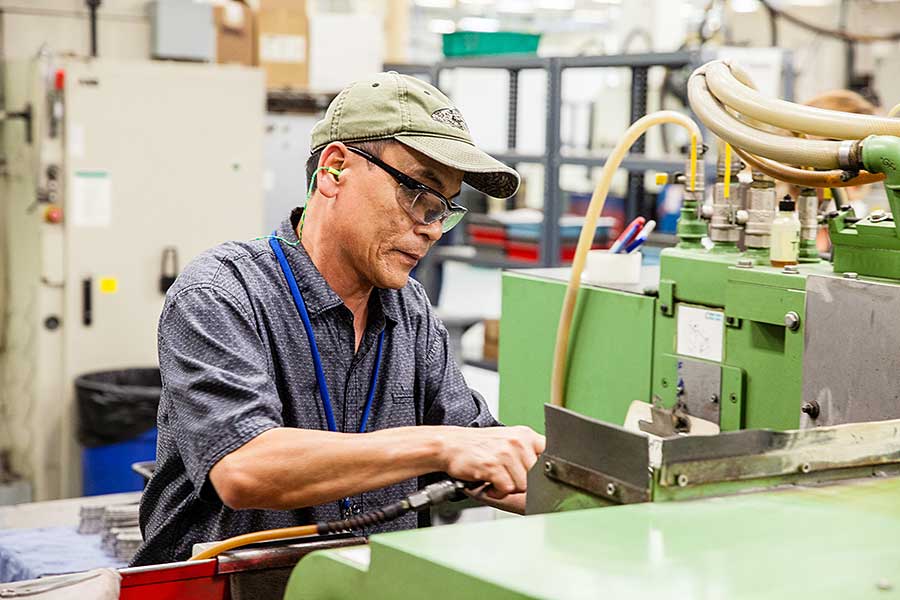 Kershaw moved production from Japan to the U.S. in the mid-’90s. | Photo by Jason Kaplan
Kershaw moved production from Japan to the U.S. in the mid-’90s. | Photo by Jason Kaplan
Welk says Kershaw is tied to the area. He offers a number of reasons why knives are so successful in Oregon: “Some people say it’s because of the liberal laws governing knife ownership and carrying in the state. Others say it’s because the area’s business environment for manufacturers is particularly good, especially when compared with California. Furthermore, Oregon’s leading city is a port city, which enables our products to get to a worldwide audience.”
Although the knife industry conjures up images of aging workmen in dimly lit workshops huddled over truck wheel sized whetstones or hammering blades from red-hot iron on an anvil, knife companies are modern manufacturing companies, run as often by knife aficionados as businessmen who happen to be in the knife business.
Tualatin’s Columbia River Knife and Tool is the latter and is a direct offspring of Kershaw, making it Gerber’s grandchild. Chairman Rod Bremer founded the company in 1994 alongside Paul Gillespie. Both had worked for Kershaw and investigated moving some production to Taiwan.
When Kershaw rejected the idea, the duo decided to follow through on their research and founded the company that is now commonly referred to as CRKT. Gillespie eventually left the company, but Bremer, a former Hallmark salesman, worked to grow CRKT to a staff of 50.
It sits off Highway 99W in a bland commercial area a mile west of Kershaw and surrounded by single-story light industrial and commercial buildings. Nearby wetlands make the area seem sparser than it is. CRKT’s headquarters is painted in varying shades of green and has no manufacturing capabilities — everything is made overseas.
The building’s foyer is filled with the spoils of hunting divided by continent — the typical ornately horned suspects from Africa on the left and the elk, deer and brown bears of North America on the right. The heads immediately define CRKT as an outdoor company, and Bremer and president Mark Schreiber sit down for an interview in a comfy boardroom that would be just as at home in a bank, private equity office or law
“It takes a long time to build a company,” says Bremer, acknowledging the supportive role social media and the internet can play in addressing a market. “When we started, it was the old-school way. The brand’s finally starting to catch.”
CRKT’s business model differs from other knifemakers in that its local activities include no manufacturing —everything is produced abroad. Bremer admits he’s “not a manufacturing guy” and says it’s unlikely the company would ever offer a U.S.-made blade. The company opened the new headquarters in Tualatin six years ago out of convenience — most of the staff lived nearby. And at CRKT, staff often means family: Bremer’s wife, Peggy, is the company’s CFO, and Schreiber is Bremer’s son-in-law.
“For us it’s personal,” Bremer says of the location.
***
Although CRKT’s Schreiber is quick to point out the supply network for other area knifemakers, he says the Portland region is good for his company in other respects. “There’s a good talent pool out there,” he says. Applicants for their rare openings often have companies like Nike, Columbia Sportswear and Adidas on their resumes.
To help attract more companies to the area, Tualatin hired Melinda Anderson in January as its own economic development manager. “We have almost 500 manufacturers in Tualatin, and 25% of the Tualatin economy is based on manufacturing,” she says. She relocated from Idaho to take the job. “The labor force is a big deal. Finding a labor force is key.”
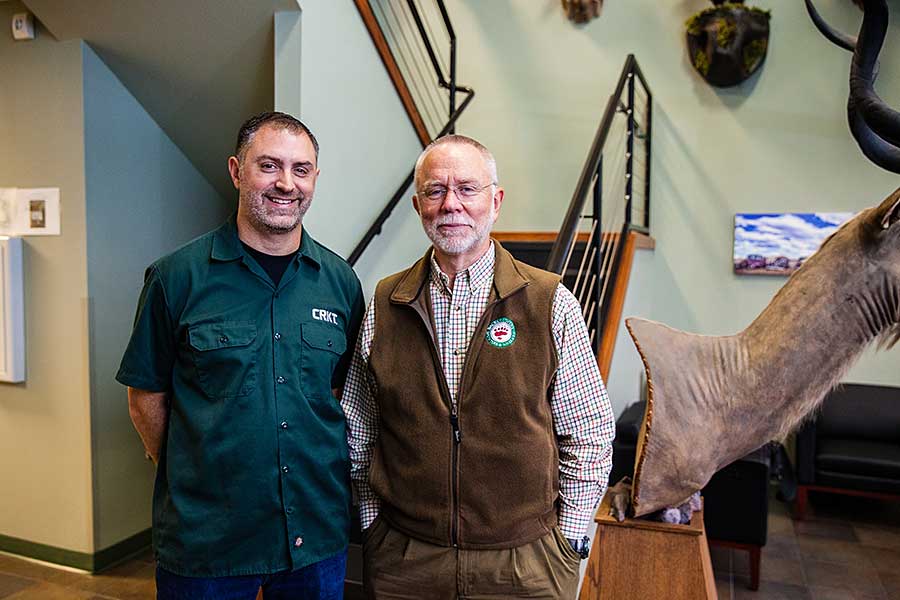 CRKT president Mark Schreiber and chairman Rod bremer. | Photo by Jason Kaplan
CRKT president Mark Schreiber and chairman Rod bremer. | Photo by Jason Kaplan
Anderson’s efforts, like Purdy’s in Tigard, may already be bearing fruit. Both Tigard and Tualatin have been cursed with suburban sprawl that makes alternative forms of transportation like cycling or walking difficult, or at least very time consuming. They also offer consumers precious little choice beyond national chains, a stark contrast to areas closer to downtown and the inner Eastside in Portland. There are signs that’s changing.
In November city voters will vote on a ballot measure that asks whether Tigard should drop its formal opposition to light rail and support extending MAX service to its downtown. A “no” vote could put an end to the Portland-to-Tualatin “Southwest Corridor” proposal that has been in the works for nearly five years. [The measure passed with a narrow margin — just 119 votes separate yes and no.]
In the meantime, Lake Oswego brewpub Stickmen Brewing Company in November will open a new taproom and brewery in Tualatin, in the same industrial area that is home to CRKT and Kershaw. Tim Schoenheit is just one of two owners of the Lake Oswego location but is opening the new brewery on his own. It will be used to expand Stickmen’s brewing capacity, allowing it to deliver its ales and lagers to other restaurants.
“We wanted to be reasonably close but where the production taproom wouldn’t interfere with the business of the restaurant,” he notes. He says he found the most real estate opportunities in neighboring Tigard, Tualatin and Wilsonville. Unfortunately, Tigard took itself out of the running thanks to regulations that prohibit a taproom in an industrial area, leaving Wilsonville and Tualatin.
“We’re probably going to start brewing in January. The taproom will hopefully open in mid-November,” he says. “The biggest combination of available [property] inventory was Tualatin. The pricing is pretty good, especially if you compare it to Portland.”
Pricing and location close to Portland, as well as broad access to transportation, make the area attractive and ready for even more investment and growth, in every corner of advanced manufacturing. Although the area suffers from the same expansive, inefficient suburban development as the edges of most cities, its companies offer an intriguing take on Oregon’s outdoor equipment industry.
The true legacy of Portland’s knifemakers seems to be next-generation employees adopting innovations their employers refused to adopt, either out of fear or lack of foresight. The one that got away for Gerber as well as its offshoots is Leatherman Tool Group. Tim Leatherman shopped his idea for a multitool throughout Tigard and Tualatin but was turned away at every corner. He then decided to go it alone, a fact several knifemakers admit regretting.
The next big company spawned by Oregon’s knife industry that will create even more jobs and bring even more cash to the region could now be incubating in the brain of one of the companies’ employees.

